Related Research Articles

Albuquerque International Sunport, locally known as the Sunport, is the primary international airport serving the U.S. state of New Mexico, particularly the Albuquerque metropolitan area and the larger Albuquerque–Santa Fe–Las Vegas combined statistical area. It handles around 5.4 million passengers annually and over 400 flights daily. ABQ is located in Bernalillo County, between the Rio Grande and the Sandia Mountains, east of Old Town and Barelas, 3 miles (5 km) southeast of downtown, south of the University of New Mexico and directly to the west of Sandia National Laboratories and Kirtland Air Force Base.

Tiles are usually thin, square or rectangular coverings manufactured from hard-wearing material such as ceramic, stone, metal, baked clay, or even glass. They are generally fixed in place in an array to cover roofs, floors, walls, edges, or other objects such as tabletops. Alternatively, tile can sometimes refer to similar units made from lightweight materials such as perlite, wood, and mineral wool, typically used for wall and ceiling applications. In another sense, a tile is a construction tile or similar object, such as rectangular counters used in playing games. The word is derived from the French word tuile, which is, in turn, from the Latin word tegula, meaning a roof tile composed of fired clay.

The New Mexico State Capitol is the seat of government of the U.S. state of New Mexico, located in its capital city of Santa Fe. It houses both chambers of the New Mexico Legislature and the offices of the Governor, Lieutenant Governor, and Secretary of State. The building is one of only eleven state capitols without a dome, and the only circular state capitol in the United States, for which it is commonly known as "the Roundhouse".

Olive Rush was a painter, illustrator, muralist, and an important pioneer in Native American art education. Her paintings are held in a number of private collections and museums, including: the Brooklyn Museum of New York City, the Haan Mansion Museum of Indiana Art, the Indianapolis Museum of Art, Indiana and the Smithsonian American Art Museum.
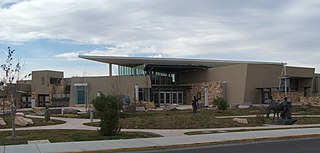
The Albuquerque Museum, formerly known as the Albuquerque Museum of Art and History, is a public art and history museum in Albuquerque, New Mexico. The museum is located in the Old Town area and is operated by the City of Albuquerque Department of Arts & Culture.

Albuquerque is the primary media hub of the US state of New Mexico, which includes Santa Fe and Las Cruces. The vistas and adobe architecture of New Mexico are a major backdrop of Western fiction and the Western genre.
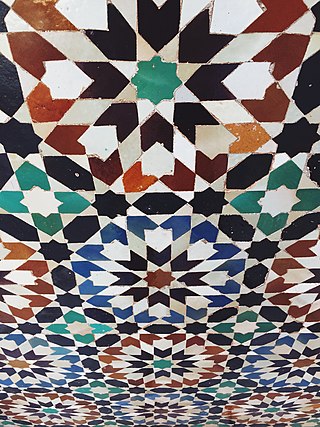
Zellij is a style of mosaic tilework made from individually hand-chiseled tile pieces. The pieces were typically of different colours and fitted together to form various patterns on the basis of tessellations, most notably elaborate Islamic geometric motifs such as radiating star patterns. This form of Islamic art is one of the main characteristics of architecture in the western Islamic world. It is found in the architecture of Morocco, the architecture of Algeria, early Islamic sites in Tunisia, and in the historic monuments of al-Andalus. From the 14th century onwards, zellij became a standard decorative element along lower walls, in fountains and pools, on minarets, and for the paving of floors.
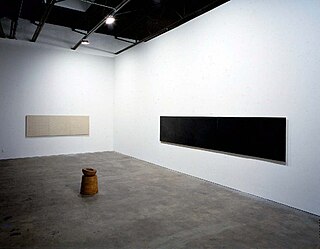
Gloria Graham is an American artist based in New Mexico. Her work includes sculpture, painting, and photography.

Helen Cordero was a Cochiti Pueblo potter from Cochiti, New Mexico. She was renowned for her storyteller pottery figurines, a motif she invented, based upon the traditional "singing mother" motif.

Margarete Bagshaw was an American artist known for her paintings and pottery. She was descended from the Tewa people of K'apovi or the Kha'p'oo Owinge, Santa Clara Pueblo, New Mexico.
Janet Lippincott was an American artist born in New York City, who lived in Santa Fe, New Mexico, from 1946 until her death. She was a part of an artistic movement called the New Mexico Modernists. Her work was abstract, and she worked in a variety of painting media and also made prints.

Alice Kagawa Parrott was a Japanese American fiber artist and ceramicist. She spent most of her adult life in Santa Fe, New Mexico, where she established a reputation as one of the country's most important weavers, and opened one of Santa Fe's first shops devoted weaving and crafts.
Florence Melva Pierce née Miller was an American artist best known for her innovative resin relief paintings. Her work has often been linked with monochrome painting and minimalism.
The Albuquerque craft beer market consists of a growing list of local emerging alcohol manufacturing and retail businesses catering to a target consumption audience. According to 2011 US Census Bureau data, the Albuquerque Metropolitan Area has 29 establishments categorized under the 445(3)(1) Beer, Wine, and Liquor stores designations. The New Mexico Secretary of State's website shows of the 123 brewing businesses applying for a license in the State of New Mexico, 70 were current and 23 were specific to Albuquerque. According to the Brewers Association, craft beers sales have grown 15% in the last year, while standard beers like Budweiser, Miller Lite, and Coors have only seen a 1% increase.

Constance DeJong is an American visual artist who works in the margin between sculpture and painting/drawing. Her predominate medium is metal with light as a dominant factor. She is currently working in New Mexico and is a professor of sculpture at the University of New Mexico. DeJong received a National Endowment for the Arts Visual Art Fellowship in 1982. In 2003, she had a retrospective at the Albuquerque Museum of Art and History. That same year, Constance DeJong: Metal was published and released by University of New Mexico Press. Her work has been described by American art critic Dave Hickey as "work worth seeing and thinking about under any circumstances".
Nanibah "Nani" Chacon is a Diné and Chicana painter, muralist, and art educator. Her work has been installed at the IAIA Museum of Contemporary Native Arts in Santa Fe, the Navajo Nation Museum in Window Rock, the ISEA International Arts and Technology Symposium, Old Town Lansing, and in the "Que Chola" Exhibition at the National Hispanic Cultural Center in Albuquerque, among other venues.
Bernadette Vigil is an American artist and illustrator whose work has been exhibited in museums and galleries nationally and abroad. She has produced permanent public artworks in the form of fresco murals for the cities of Santa Fe and Albuquerque, New Mexico. She has been commissioned to create religious frescoes in churches in New Mexico, and has been called a "master of the art of buon fresco" in the Santos Tradition. She has authored a book on Toltec spirituality, Mastery of Awareness: Living the Agreements. In 2002 it was published in Spanish as El Dominio de la Conciencia, and in 2005 it was published in German as Das Geheimnis der vier Versprechen.
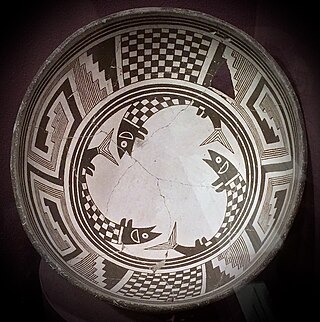
Pueblo pottery are ceramic objects made by the indigenous Pueblo people and their antecedents, the Ancestral Puebloans and Mogollon cultures in the Southwestern United States and Northern Mexico. For centuries, pottery has been central to pueblo life as a feature of ceremonial and utilitarian usage. The clay is locally sourced, most frequently handmade, and fired traditionally in an earthen pit. These items take the form of storage jars, canteens, serving bowls, seed jars, and ladles. Some utility wares were undecorated except from simple corrugations or marks made with a stick or fingernail, however many examples for centuries were painted with abstract or representational motifs. Some pueblos made effigy vessels, fetishes or figurines. During modern times, pueblo pottery was produced specifically as an art form to serve an economic function. This role is not dissimilar to prehistoric times when pottery was traded throughout the Southwest, and in historic times after contact with the Spanish colonialists.
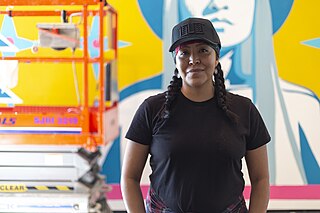
Lynnette Haozous a Native American painter, printmaker, jeweler, writer, and actor. She is an enrolled member of the San Carlos Apache Tribe and of Chiricahua Apache, Navajo, and Taos Pueblo ancestry. Haozous works in acrylics, watercolors, spray paint, jewelry, screen-printing, writing, and acting on stage and in film. She is known for her murals and uses a blend of art and advocacy to bring attention to social conditions and injustices.
References
- 1 2 3 4 5 6 7 Traugott, Joseph (2015). Visualizing Albuquerque: Art of Central New Mexico. Albuquerque, New Mexico: Albuquerque Museum. p. 188. ISBN 978-0-9779910-8-2.
- 1 2 3 4 5 6 7 Paskus, Laura (September 14, 2015). "High Country News". High Country News. Retrieved March 24, 2018.
- ↑ "Beverley Magennis". The RAiR Foundation. Retrieved 2021-05-15.
- ↑ McGarrell, Ann; Anderson, Sally (2007). The Roswell Artist-in-Residence Program: An Anecdotal History. Albuquerque, New Mexico: University of New Mexico Press. pp. 69–70.
- 1 2 3 4 5 Traugott, Joseph (2012). New Mexico Art Through Time: Prehistory to the Present. Santa Fe, New Mexico: Museum of New Mexico Press. pp. 197–198.
- 1 2 3 Poling, Charles (Spring 2007). "Su Casa Southwestern Homes". Su Casa. Archived from the original on 2008-05-17. Retrieved March 24, 2018.
- 1 2 ABQ Journal News Staff (April 25, 2015). "'Albuquirky' tour features funky houses". Albuquerque Journal. Retrieved March 24, 2018.
- ↑ "Beverley Magennis | Tamarind Institute" . Retrieved 2021-05-15.
- 1 2 Magennis, Erin. "ABQ Art Glass". Archived from the original on March 25, 2018. Retrieved March 24, 2018.
- ↑ "CultureNOW - Mexican Hat: Beverly Magennis and City of Albuquerque Public Art Program" . Retrieved March 24, 2018.
- ↑ "Full Circle". Public Art Archive. Retrieved June 18, 2023.